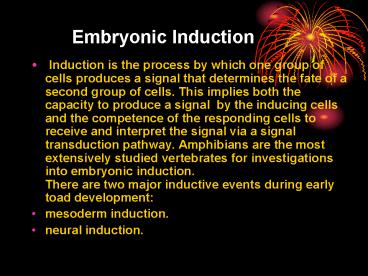Embryonic Induction - PowerPoint PPT Presentation
1 / 13
Title:
Embryonic Induction
Description:
Induction is the process by which one group of cells produces a ... There are two major inductive events during early toad development: mesoderm induction. ... – PowerPoint PPT presentation
Number of Views:6176
Avg rating:3.0/5.0
Title: Embryonic Induction
1
Embryonic Induction
- Induction is the process by which one group of
cells produces a signal that determines the fate
of a second group of cells. This implies both the
capacity to produce a signal by the inducing
cells and the competence of the responding cells
to receive and interpret the signal via a signal
transduction pathway. Amphibians are the most
extensively studied vertebrates for
investigations into embryonic induction. There
are two major inductive events during early toad
development - mesoderm induction.
- neural induction.
2
- Mesoderm Induction
- Mesoderm induction occurs over an extended period
of time in the equatorial region of the embryo
from about the 32-cell stage to the beginning of
gastrulation. The requirement of induction for
production of mesoderm is evident by comparing
the embryonic fate map (which shows the fates of
regions of the embryo during normal development)
to the specification map (which shows what tissue
explants can do in isolation) during cleavage
stages. - The fate map shows that about half of the
mesoderm arises from cells above the equatorial
pigment boundary, whereas no cells from above the
pigment boundary will form muscle or notochord in
isolation. The vegetal cells are not equal in
their inductive capacities. The dorsal vegetal
cells induce axial mesoderm of the dorsal
midline (notochord and segmented muscle), whereas
the remaining vegetal cells induce ventrolateral
mesoderm (mesothelium, mesenchyme, blood cells). - These observations have led to the proposal that
there are two mesoderm-inducing signals - A general vegetal signal that operates around the
circumference and induces ventral mesoderm. - A dorsal vegetal signal that induces the axial
mesoderm (i.e., Spemann's organizer). - The general vegetal signal
apparently remains operational in ventralized
embryos produced by UV irradiation of fertilized
eggs these radially symmetrical embryos have the
normal amount of mesoderm, but all of it is
ventral in character. The dorsal vegetal signal
is dependent upon dorsalization factors.
3
- Neural Induction
- Spemann's Organizer substance
- The developmental significance of the
dorsal lip of the blastopore, which is derived
from the gray crescent, was initially
demonstrated by Spemann and Mangold. The dorsal
lip material transplanted to the ventral side of
a host gastrula would induce a secondary embryo.
The transplanted dorsal lips induced the
overlying host ectoderm to develop as neural
tissue through vertical signaling. - Spemann-Mangold experiment
- Regional determination by the chordamesoderm
- Planar (lateral) vs. vertical signaling
- The involuting dorso-anterior mesoderm
induces the adjacent mesoderm to form anterior
neural tissue. As the mesoderm migrates toward
the former animal pole, it induce to form
anterior neural tissue. With the advancement of
involution , ectoderm is induces the formation of
posterior neural elements. According to this
model, the anteroposterior character of the
neural ectoderm is dependent. Interestingly, when
BMP-4 signaling is blocked in animal caps, neural
tissue is formed in the absence of neural
inducers.
4
- BMP-4 is expressed throughout the gastrula of
Xenopus, except for the dorsal lip and animal cap
regions. Both the mesoderm and ectoderm are
patterned by antagonizing signals, with BMP-4
acting to ventralize them. If the effects of
BMP-4 are counteracted, the mesoderm develops
dorsal properties, and the ectoderm becomes
neural tissue. - At this point, three secreted factors have
been identified as likely neural inducers - Noggin Secreted factors that can dorsalize the
mesoderm. - Chordin Secreted factors that can dorsalize the
mesoderm. - Follistatin Is an activin antogonist that can
also dorsalize mesoderm when injected as mRNA.
5
(No Transcript)
6
(No Transcript)
7
(No Transcript)
8
(No Transcript)
9
(No Transcript)
10
(No Transcript)
11
(No Transcript)
12
(No Transcript)
13
(No Transcript)































